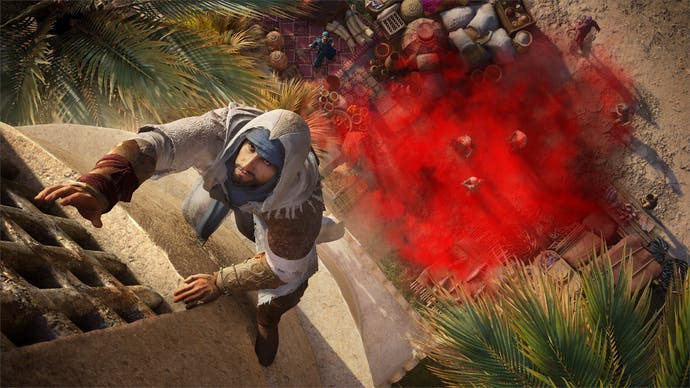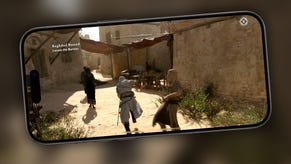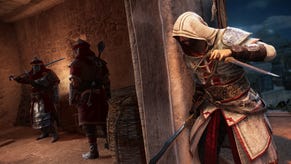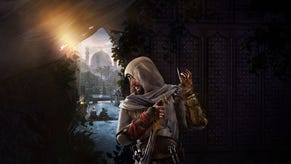Assassin's Creed Mirage feels a clear-sighted return to the series' roots
Just deserts.
Assassin's Creed Mirage marks the first time Ubisoft Bordeaux has led development on a full game release. It's a relatively small studio, as far as Ubisoft's teams go, and it seems fitting the team was chosen to build the leaner and more focused Mirage - after previously putting together Valhalla's Wrath of the Druids. Mirage was, of course, originally set to be DLC for Valhalla as well, before the project was expanded and became a standalone adventure for that game's mysterious Assassin character Basim Ibn Ishaq, set in the Assassin's Creed franchise's original stomping grounds.
Baghdad really is the perfect setting for Mirage's vision - to return to the roots of the Assassin's Creed series with an homage to its original game. And, after playing it myself, I can say Bordeaux has done a great job of doing just that. There's a return to stealth and scouting as a focus which really recreated that feeling of classic Assassin's Creed gameplay, especially now that social blending is back and, thanks to the tightly-packed, busy streets of Baghdad's Round City and its surrounding towns, parkour is once again at the forefront of the action when it comes to avoiding combat and just generally getting from place to place - although there is also the option to fast travel to previously synchronised viewpoints if you're feeling lazy.
The Round City itself is impressive as well, and it's not like the classic desert city you might imagine. There's canals, acres of greenery and multiple districts with distinct buildings and architecture that are immediately reminiscent of the first game. The Round City is so called because it is encircled by a gigantic round wall, which has 4 different gates Basim can use to enter or exit it. Each gate leads to a different outer district, such as Karkh, a market town that marks the mid-way point of the Silk Road that's full of crowds and traders, and Hariyah, a district that's dedicated to workers and industry with fabric dyeing factories, brick factories full of workers, a prison and the Grand Mosque. Finally there's also Abbasiyah, an area that holds The House of Wisdom - a place full of scholars who study maths and philosophy.
Some sections of Mirage's world also make time for fans of the more modern, open games like Valhalla and Origins too - fans who may not have played the originals before. At the start of the game, Basim is a simple thief, doing odd jobs for the proto-Assassin Hidden Ones in the small town of Anbar. It's the perfect training ground to learn the ropes before you head into Baghdad proper, full of parkour opportunities and bustling crowds to lose your pursuers in. Between Anbar and The Round City, however, and in fact encircling The Round City on the map, are areas called The Wilderness - which are wider, more open areas that give you an open vibe much closer to that of Valhalla. These areas can act as a nice refresher from your time running around the confines of a city, but aren't essential to explore. Mirage is far more of a narrative-driven experience than Valhalla, so you'll only need to really head to these areas if you're driven there by your investigations. Whatever era of Assassin's Creed you like the most, you're going to get the best of both worlds here. Unless your favourite game is Assassin's Creed Black Flag that is. I'm pretty sure there isn't any ship sailing in this one.
One area in Mirage that doesn't feature on the main map is the fortress of Alamut, which I also got to visit in my hands-on demo. Alamut was a stronghold for the Hidden Ones located in Persia, and in Mirage you visit the fortress as it is being constructed in order to learn the Hidden Ones' ways. This means you get to experience combat training, rock climbing, knife throwing and even get to witness one of Basim's first attempts at a Leap of Faith. It's an interesting area that will resonate with hardcore fans of Assassin's Creed lore as, not only is it a legendary location that's been mentioned in multiple games and books, but it's also stuffed full of Easter Eggs for lore lovers to hoover up. This area did feel the most linear of all the places I visited - like a Tutorial Town with a very slow pace and lots of dialogue - but nevertheless, mega fans are going to be thrilled they can pay a visit.
It wasn't until the last portion of my gameplay demo that I finally got to enter The Round City and catch a glimpse of the game's full potential, along with a host of new and returning gameplay changes. Social blending is back, which is an excellent way of losing pursuers and reducing your notoriety level. This notoriety system is new for Mirage and gives you progressive retaliation from NPCs, so if you've been caught doing something dodgy, like, say failing a pickpocketing mini-game - basically a one-button quick-time event - NPCs will run and alert guards. This will not only mean the guards will start searching for you, but it will also make friendly NPCs more wary of you, especially if your notoriety level is really high. If so, they in turn will alert guards to your position if they're suitably agitated. To avoid the guards, I was told you can do things like bribe musicians to create distractions - or, as a last resort, get into a fight.
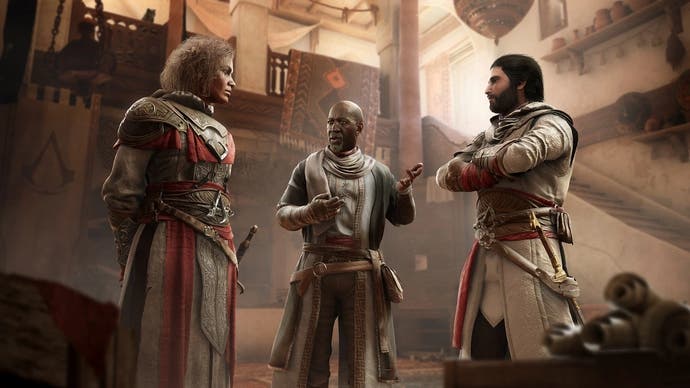
It feels like combat should really come as a last resort due to Mirage's emphasis on stealth, and fighting multiple opponents is especially risky, even though Basim has some cool moves under his belt. One such ability is the new Assassin's Focus, which allows you to mark multiple targets and kill them in the blink of an eye -perfect for clearing out rooms that hold multiple foes without them calling for backup. This is one of the skills that feature in Mirage's three linear progression trees, which let you upgrade your eagle Enkidu, your tools like noise makers, smoke bombs, blow darts and throwing knives, and your combat skills.
Once I did get to The Round City, it quickly became clear that the main core of the gameplay revolved around 'Investigations', which make up the backbone of Mirage's story. By opening a menu called The Investigation Board, you'll be presented with something that looks fairly similar to one of those cork boards you see in detective movies - where individual clues and suspects are linked together by threads. By consulting this board, you'll be able to track objectives and in turn hunt down clues that will ultimately unlock a Black Box mission, which are missions with a main assassination target who you'll need to track down and kill. In my hands-on session, these investigations had me chasing stolen tea leaves for a trader named Kong, which then put me on the trail of a stolen hairpin artefact. After a great deal of sneaking around and stabbing people in the back of the head, I discovered that this hairpin was due to be auctioned off at bazaar later in the day and, once I reached it, I was then tasked with gathering intel that would eventually lead me to the location, and the identity of the target.
I won't go much more into that due to spoilers, but the things I had to do to find them included eavesdropping, bribing, basic platforming puzzles that involved moving things and blowing things up and of course, a fair amount of murder too. The pace of the gameplay may be a bit slower, and despite the illusion of choice this section felt a lot more linear than other parts of the game, but still I was a fan and it had a satisfying conclusion. All in all, I enjoyed my time being more of a Batman-style assassin in a smaller, more contained area far more than I did wandering around in the bigger open areas of recent Assassin's Creed games. Mirage certainly captures that nostalgic feeling of hunting for targets, back on the rooftops like Assassin's Creed 1.
